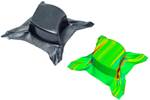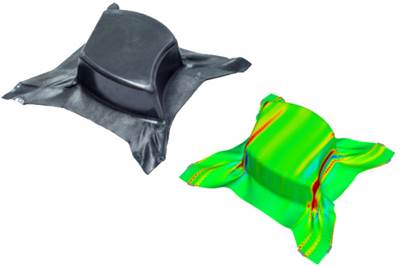Guidance for the thermoforming process
A briefing on some of the common foam core material types, forming methods and tooling requirements.
Creep (top), vacuum forming (middle) and compression molding (bottom) processes.
Thermoforming rigid foam core sheets has been on my radar lately, spurred by questions from an Abaris client about forming polymethacrylimide (PMI) core. After doing a little research on PMI materials, we found answers and provided solutions to the customer. Then we decided to gather data on other universally used foam core materials for our own internal use. Some of what we learned is shared here.
Rigid foam core sheets can be tricky to thermoform because these products tend to have an extremely low heat transfer coefficient (HTC) and high insulation (R) values. These properties are affected by changes in foam density and material thickness. The higher the density, the longer it takes to get to temperature and the higher the pressure needed to form it. Moreover, when the thickness is too great, the material cannot be heated uniformly through the cross-section, making it less suitable for forming. For these reasons, forming is typically limited to sheets that are ≤25.4-millimeters (1.0-inch) thick. Any thicker than that may require casting/molding to the desired shape, machining from thicker block stock, or choosing another core material option. Also, as a rule, the minimum inside bend radius for thermoforming is two times the core thickness (e.g., 25.4-millimeter (1-inch) core thickness requires a 50.8-millimeter (2-inch) inside radius).
Closed-cell foam sheets are susceptible to moisture uptake. Lower density foam cores typically absorb more water than the higher density cores, as the area of the surface cells are greater (larger surface void size). Most manufacturers recommend a drying process prior to forming and controlled storage afterwards, before layup or bonding. In addition, some core materials need thermal conditioning to minimize outgassing — especially after a machining process. Conditioning the foam greatly reduces chemical activity at the surface that may otherwise negatively react with the resin or adhesive used to bond the core in the next operation.
Not all foam core materials are formable; however, most manufacturers specify which products can be formed and which cannot. Datasheets are available for selected formulas that list physical, mechanical and thermal properties — these are necessary for developing a sound thermoforming process. The ideal forming temperature for each type of core is slightly above the glass transition temperature (Tg) and significantly below the melt temperature (Tm).
Airex (PVC and PET) core materials are thermoformable and have a range of core types, densities, and processing temperatures as shown in Table 1.
Table 1. Thermoforming temperatures for Airex core. Source | Abaris Training Resources Inc.
Last-A-Foam (PU) FR-4300 series core is listed in the manufacturer’s product selector as the company’s preferred thermoformable formula. Core types, densities and processing temperatures are found in Table 2.
Table 2. Thermoforming temperatures for Last-A-Foam FR-4300 series core. Source | Abaris Training Resources Inc.
Rohacell (PMI) foam core materials are all thermoformable. Core types, densities and processing temperatures are found in Table 3.
Table 3. Thermoforming temperatures for Rohacell foam core. Source | Abaris Training Resources Inc.
Forming methods and tooling requirements
Hot creep forming
Figure 1. This method uses weights to form the core into a mold as it is heated in an oven. Source | Airex Processing Guidelines
This method uses sandbags (or similar weighting methods) on top of a sheet of core spanning across a female mold, which is then placed in an oven and heated to the forming temperature and later, cooled with the weights in place (Fig. 1). This method can also be adapted to use a matched mold setup with a base tool and a weighted upper tool.
Vacuum forming
Figure 2. This method uses a flexible vacuum bag to form the core into the mold after it is heated in an oven or autoclave. Source | Airex Processing Guidelines
Vacuum forming can be done in an oven or autoclave using a vacuum bag as an inside flexible membrane (Fig. 2). A layer of lightweight, stretchable, breather material is used to sandwich the core inside the bag and provides both a breather path and a slip surface between the tool and core. Heat to the forming temperature prior to applying full vacuum and apply autoclave pressure if applicable for thicker or higher density materials.
Compression molding
Figure 3. This method uses a preheated sheet of core placed into a matched die set in a press to thermoform the core. Source | Airex Processing Guidelines
Used to form complex shapes to close tolerances, compression molding uses a heated metal matched die set installed in a low-pressure press. The foam sheet is heated to its forming temperature for the proper amount of time, prior to placement in the die. This is done with a multi-zone hot air oven placed directly in line with the press. The core is then cooled to a stable temperature prior to removal from the die (Fig. 3).
Before attempting a full-blown thermoforming process, it is recommended that the reader experiment with the actual core materials (type, density and thickness) that they intend to use and identify the ideal forming temperature and pressure needed to successfully form their material. This can be done using a scaled-down creep forming setup where the core is supported on blocks, is weighted in the center and is heated until it sags. This will provide a good starting point for developing a formal thermoforming process.
Notes
1Airex – available from Baltek Inc. (High Point, N.C., U.S.),
2Last-A-Foam – available from General Plastics Manufacturing Co. (Tacoma Wash. U.S.),
3Rohacell – available from Evonik (Parsippany-Troy Hills, N.J., U.S.),
Related Content
Active core molding: A new way to make composite parts
Koridion expandable material is combined with induction-heated molds to make high-quality, complex-shaped parts in minutes with 40% less material and 90% less energy, unlocking new possibilities in design and production.
Read MorePUR composite sandwich panels for 3D automotive parts, high-volume panels and more
At its U.S. sites, Ascorium produces glass fiber/PUR 3D parts via semi-automated molding, high-volume flat panels via a continuous line while working toward bio-based PUR and recycling.
Read MoreCo-molding SMC with braided glass fiber demonstrates truck bed potential
Prepreg co-molding compound by IDI Composites International and A&P Technology enables new geometries and levels of strength and resiliency for automotive, mobility.
Read MoreOrbital Composites wins AFWERX award for Starfighter drone fleet
Under the TACFI contract, Orbital is implementing the AMCM process to build 3D printed composite multi-mission UAS aircraft, surpassing $10 million in government awards.
Read MoreRead Next
Troubleshooting thermoforming of thermoplastic composites
Challenges with the thermoforming/stamping process and potential solutions addressing the associated parameters and complex material behaviors.
Read MoreUltrasonic welding for in-space manufacturing of CFRTP
Agile Ultrasonics and NASA trial robotic-compatible carbon fiber-reinforced thermoplastic ultrasonic welding technology for space structures.
Read More










